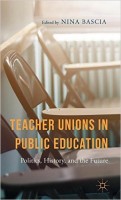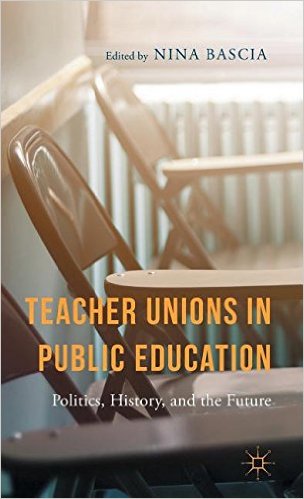 Editor: Nina Bascia
Editor: Nina Bascia
Publisher: Palgrave Macmillan – 220 pages
Book Review by: Paiso Jamakar
Membership in labor unions in the United States has been steadily declining over the last four decades, according to a January 23, 2015 article by Melanie Trottman in the Wall Street Journal. In 1973, among employed workers all over the country, about 25 percent were union members. By 2014 that number had dropped to just around 11 percent.
In the private sector in the U.S. the situation is very different, with much fewer workers belonging to labor unions. Union membership declined from 37 percent of workers in 1952 to only about six percent in 2011, writes Lee E. Ohanian in a November 26, 2011 article in a publication of the American Enterprise Institute. Presently that number may be even smaller.
The situation in Canada is not as bad as in the U.S. In an article of the Industrial Relations Center at the School of Policy Studies of Queens University, the author Mary Lou Coates writes: “However there are indications that all is not well. Despite steady increases in union membership, union growth in Canada has certainly not been as robust in recent years as it was in the 1960s and 1970s…membership in unions which hovered around 38 percent in the early 1980s has declined to 36 percent in recent years.” A chart shows the 36 percent in 1991; what is it now in 2015?
This book about the politics, history and the future of teacher unions in Canada covers the following issues, as shown in its Contents pages:
- Perspectives on Teacher Unions: History, Discourse, and Renewal
- Histories
- Gender and Status: Ontario Teachers’ Association in the Nineteenth Century
- Defending Teachers’ Rights and Promoting Public Education: Evolving and Emerging Union Strategies within a Globalized Neoliberal Context
- Remembering, Reimagining, and Reviving Social Justice Teacher Unionism
- Discourses
- Fragility and Volatility in Teacher Union-Governmental Relations
- Model Citizen or Bad Influence? The Contested Nature of Teachers’ Public Activism
- The Formal and Informal Contexts of Union Socialization
- Renewal
- Classroom, Community, and Contract: A New Framework for Building Moral Legitimacy and Member Activism in Teacher Unions
- Why and How a Teacher Union Supports Autonomous Teacher Professional Development in an Age of New Managerialism
- Crossing Boundaries to Support Strategic Foresight
- Education Reform in England and the Emergence of Social Movement Unionism: The National Union of Teachers in England
- The Teachers’ Trifecta: Democracy, Social Justice, Mobilization
- Conclusion
Nina Bascia writes that presently, teaching, public schooling, and teacher unions “face unprecedented threats in the face of neo-liberal educational reforms. Choice, competition, incentives, and accountability have become central principles in the global policy agenda and in the restructuring of educational systems. Jurisdictions around the world have seen increase in governmental support for educational privatization.”
Governments in numerous countries are having difficulty funding education adequately, especially for members of the lower economic strata. As a result of the combined pressures of having accountability as well as having limited resources, there is now “greater standardization in programming, reporting systems that emphasize surveillance, and an infrastructure that is lacking on support for teaching and learning,” Bascia states in the first chapter.
She makes these important points:
- Teachers are at the center of many current educational reform efforts
- New policies place tight controls on what is taught and how teaching is carried out
- New inspection practices affect teachers in terms of “bureaucratization, stress, demotivation, alienation, and insecurity.”
- The crisis in teaching and teachers’ work has led to significant proportions of the teaching population exiting the profession.
- Teachers’ needs for organized representation thus are more pronounced than ever
As you read this book, you will be able to better understand the pros and cons of these and other related issues and put the subject of teacher unions, particularly in Canada, in proper perspective.
Editor:
Nina Bascia is Professor and Director of the Collaborative Program in Educational Policy at the Ontario Institute for Studies in Education in Ontario, Canada
Contributors:
Nina Bascia
James Chamberlain
J.C. Couture
Larry Kuehn
Justine Mercer
Charlie Naylor
Pamela Osmond-Johnson
Ben Pogodzinski
Wendy Poole
Kara Popiel
Cindy Rottman
Harry Smaller
Howard Stevenson
Christine Stewart / Galksi-GibayKwhl Sook’
Katy Swalwell
Jane Turner
Lois Werner







